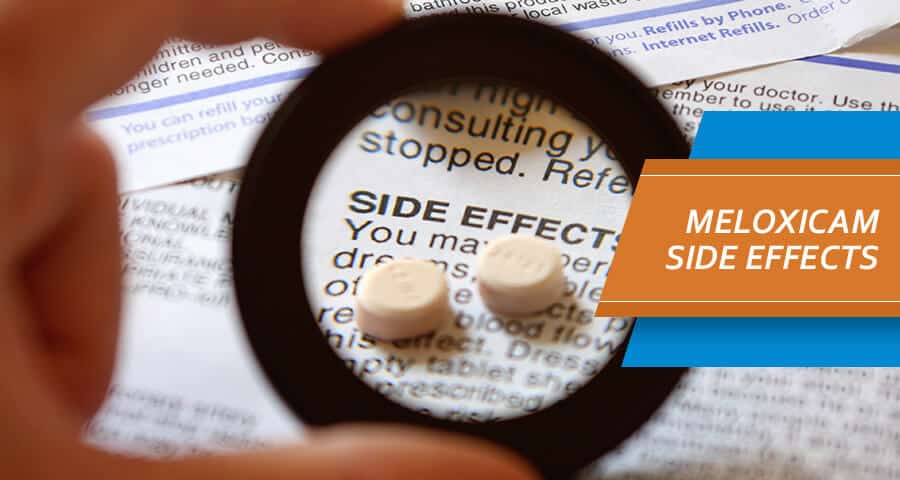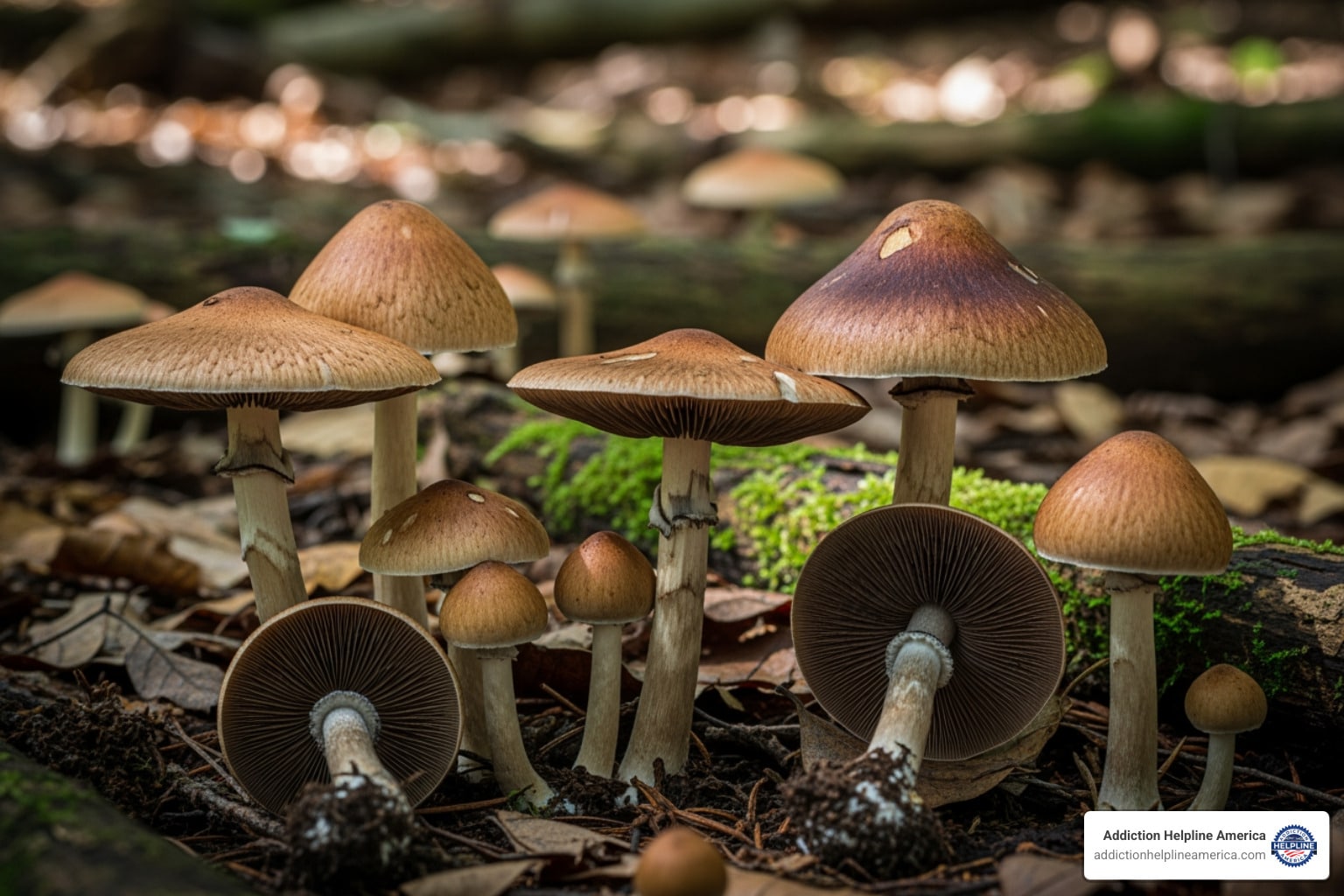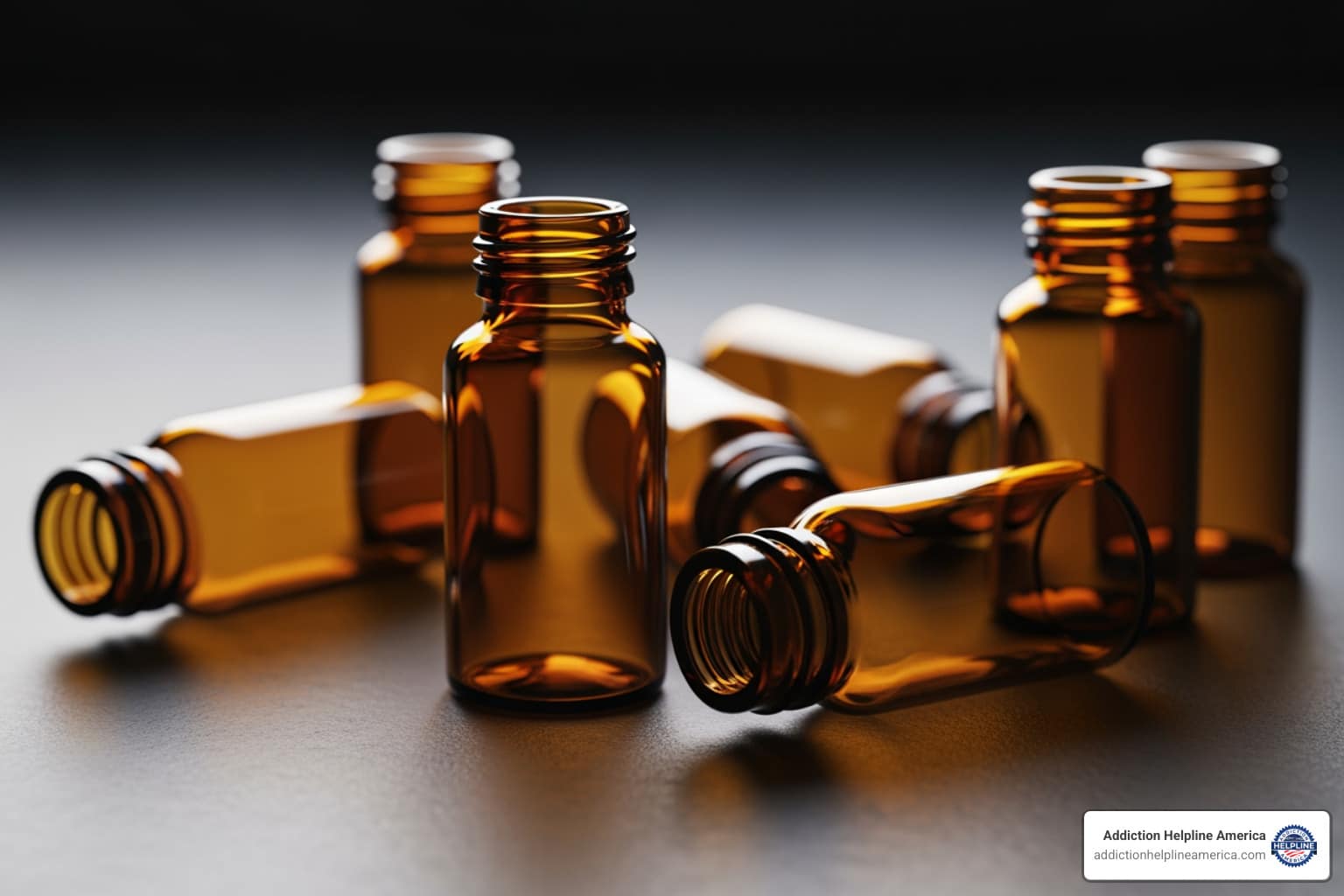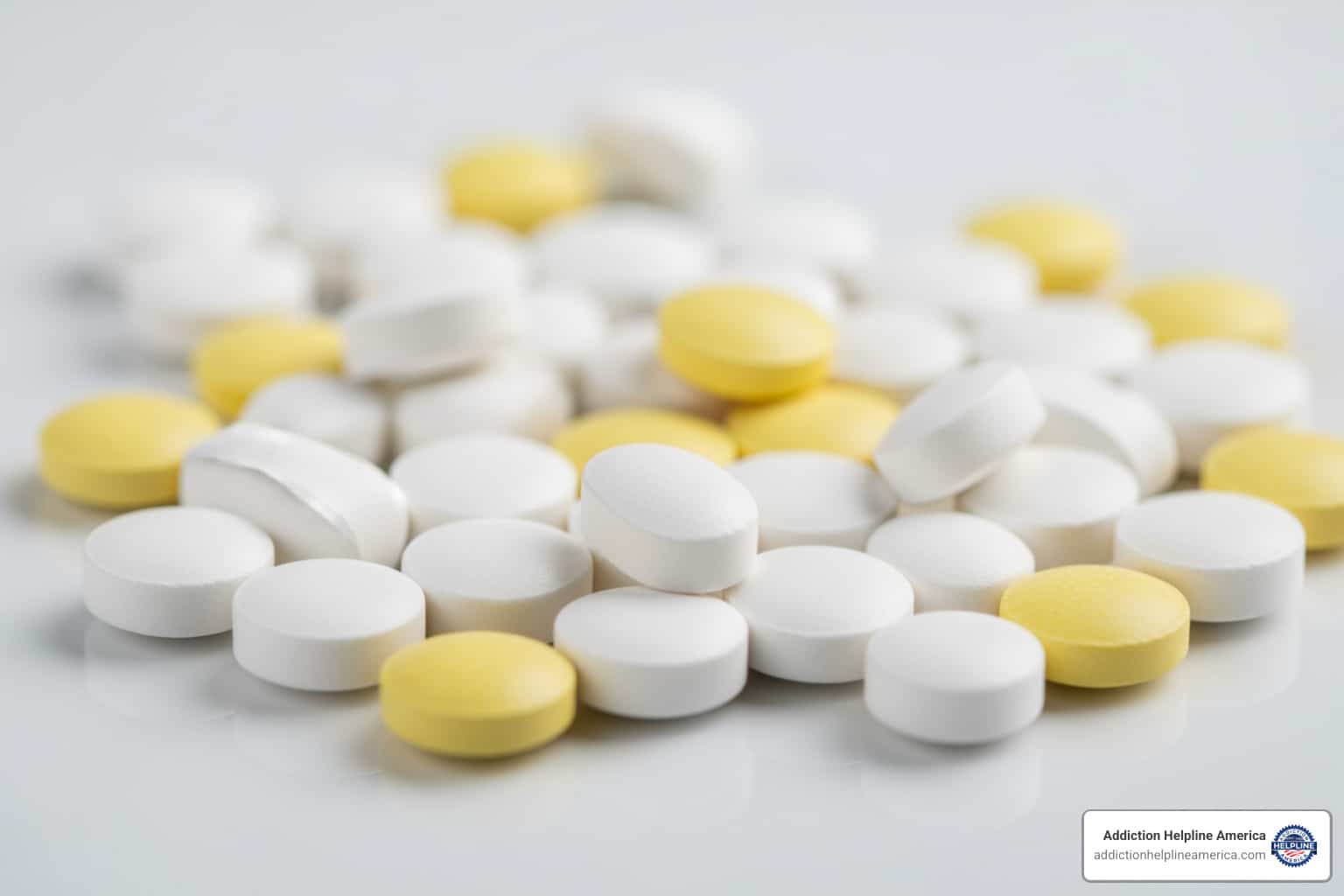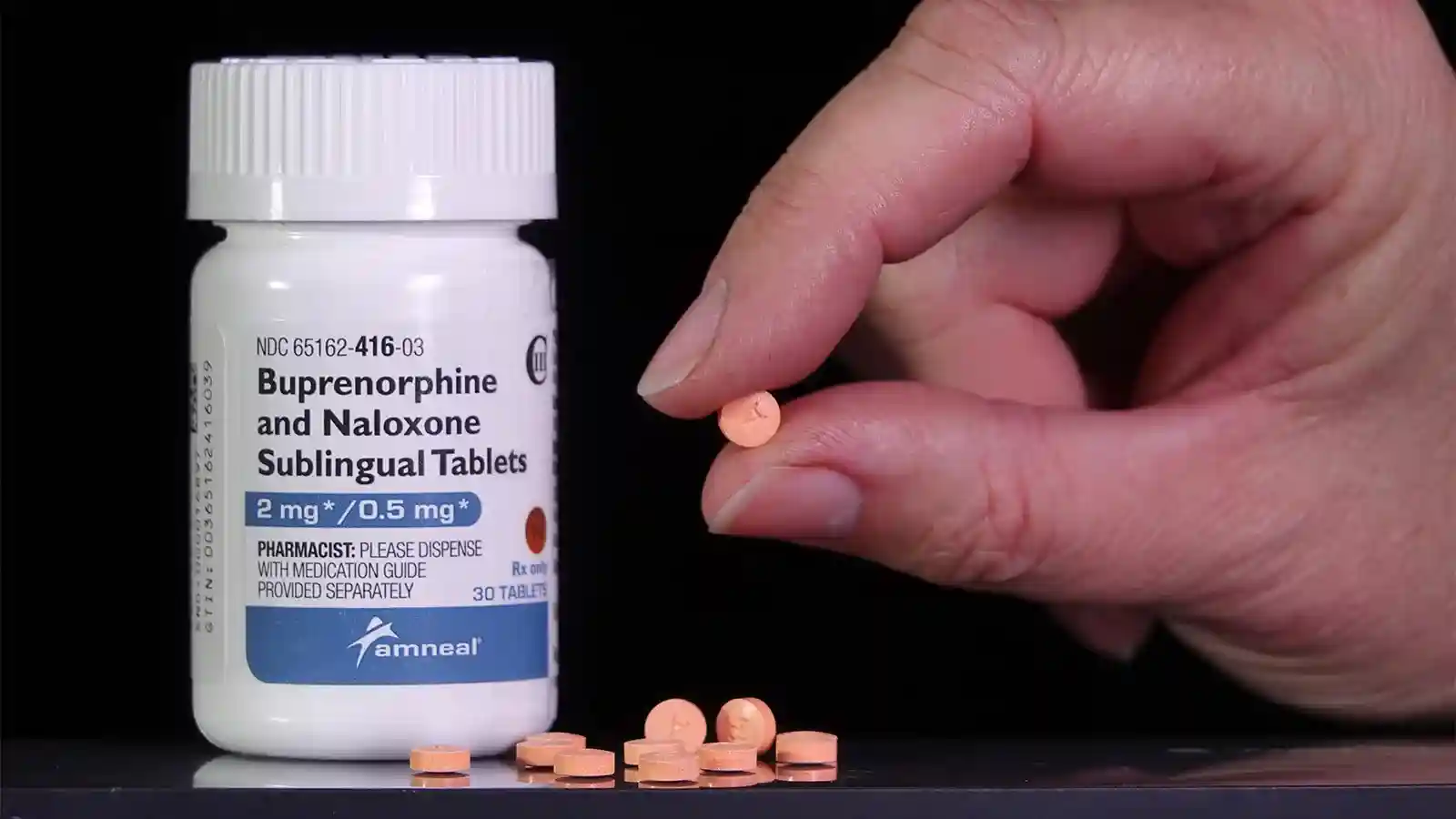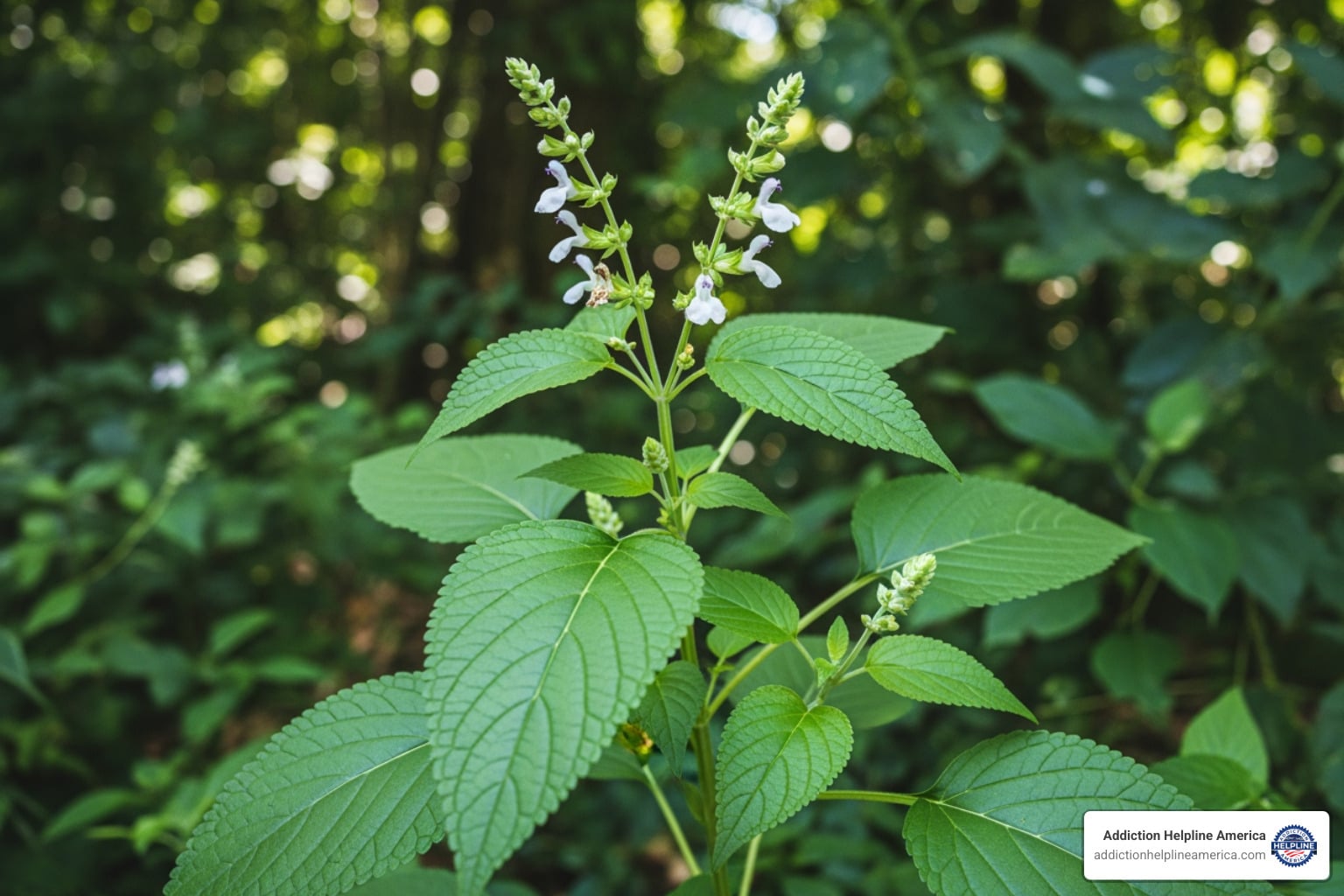
Understanding Divinorum: A Powerful Plant with Profound Effects
Divinorum (properly called Salvia divinorum) is a psychoactive plant from the mint family that produces some of the most intense, short-lived hallucinations known to science. Here’s what you need to know:
Quick Facts About Divinorum:
- What it is: A perennial herb native to Oaxaca, Mexico, historically used by Mazatec shamans
- Active compound: Salvinorin A – one of the most potent naturally occurring hallucinogens
- How it works: Acts on kappa-opioid receptors in the brain (unlike typical psychedelics)
- Duration: 5-30 minutes when smoked; up to 2 hours when chewed
- Effects: Intense hallucinations, altered reality, loss of motor control, out-of-body experiences
- Legal status: Not federally controlled in the US, but illegal in many states and countries
- Street names: Ska María Pastora, Sally-D, Diviner’s Sage, Seer’s Sage
Unlike substances like LSD or psilocybin that target serotonin receptors, divinorum works through a completely different brain pathway. This makes its effects uniquely disorienting and often frightening. Users report feeling like they’ve become furniture, experiencing “spatiotemporal dislocation,” or losing complete awareness of their identity.
The effects are extremely unpredictable. What seems like a “mild” dose to one person can trigger a terrifying experience for another. Physical risks include falls and injuries from complete loss of coordination and contact with reality.
Recent statistics show declining use – only 0.8% of students reported using it in 2022, down from 5.7% in 2009. While some research suggests potential therapeutic applications for pain and inflammation, divinorum remains largely unstudied in humans, and its safety profile is poorly understood.
At Addiction Helpline America, we support individuals and families navigating substance use, including emerging substances like divinorum. Our team understands that using powerful psychoactive plants can have unexpected consequences that require professional support.

What is Salvia Divinorum?
The ‘Sage of the Diviners’ Divinorum belongs to the Lamiaceae family—the same botanical family as basil and mint. But unlike its culinary cousins, this herb produces some of nature’s most powerful psychoactive effects.
The plant itself thrives in the misty cloud forests of the Sierra Mazateca region in Oaxaca, Mexico. It grows at elevations between 980 and 6,000 feet, where the cool, humid conditions create the perfect environment for this perennial herb to flourish.

The names given to divinorum tell you everything about its sacred history. “Ska María Pastora” translates to “Leaves of Mary, the Shepherdess.” Other names like “Diviner’s Sage” and “Seer’s Sage” point to its long-standing role as a spiritual tool rather than a recreational substance.
Origins in Mazatec Shamanism
For generations, Mazatec shamans in northern Oaxaca have used divinorum as a sacred medicine in healing and divination ceremonies, entering visionary states to communicate with the spiritual world.
These weren’t casual experiences. The ceremonies served serious purposes—diagnosing illnesses, seeking guidance, and treating both physical and emotional ailments.
The traditional method involved chewing fresh leaves. Shamans would roll the leaves into a bundle called a “quid” and hold it in the mouth for extended periods. The active compounds absorbed slowly through the tissues of the mouth, creating a gentler, longer-lasting experience than modern smoking methods. Sometimes they prepared water-based infusions from crushed leaves instead.
The Mazatec also used divinorum as a traditional medicine for conditions like headaches, stomach problems, and rheumatism, showing how integrated the plant was in their healing practices.
The Unique Active Compound: Salvinorin A
What makes divinorum so powerful? The answer lies in a compound called salvinorin A, found in the tiny hair-like structures (called glandular trichomes) covering the leaves.
Salvinorin A is extraordinary for its potency. Active at doses as small as 200 micrograms, it is one of the most powerful naturally occurring hallucinogens known.
Its chemical structure is also a scientific oddity. Unlike most hallucinogens (like LSD or psilocybin), salvinorin A contains no nitrogen. Classified as a neoclerodane diterpenoid, it is the first documented diterpene hallucinogen, which helps explain its unique effects.
In dried plant material, salvinorin A makes up roughly 0.18% of the leaf. But commercial extracts concentrate this compound dramatically. You’ll see products labeled 5X, 10X, 20X, or even 60X—indicating they’re five to sixty times stronger than the natural leaf. These concentrated forms produce much more intense and immediate effects, which significantly increases the risks involved.
Understanding where divinorum comes from and what makes it so powerful helps explain why its effects can be so overwhelming and why it deserves serious respect and caution.
The Intense Effects and Serious Risks of Divinorum
Divinorum differs from psychedelics like LSD because of how it works in the brain. Its active compound, salvinorin A, is a potent kappa-opioid receptor (KOR) agonist, whereas LSD affects serotonin receptors. This unique mechanism creates an “atypical psychedelic” experience that is often more disorienting, intense, and dysphoric.
The kappa-opioid pathway is associated with stress responses and dysphoria (feelings of unease or dissatisfaction), which helps explain why divinorum trips can feel so different—and often more unsettling—than experiences with other psychedelics.
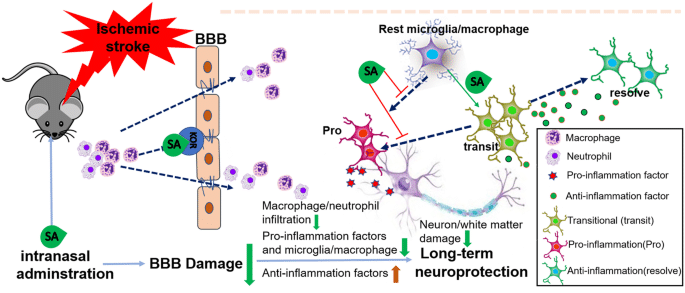
How Divinorum Affects the Brain and Body
When someone uses divinorum, the effects hit fast—especially when smoked. The experience is often described as completely overwhelming, even by people familiar with other psychedelics.
The mental effects are profoundly disorienting. Users report intense visual, auditory, or tactile hallucinations, but the experience goes beyond simple distortions. Many describe their sense of reality fragmenting or completely altering.
One of the most striking—and often frightening—effects is the sensation of leaving your body entirely. Some users experience what’s called “spatiotemporal dislocation,” feeling like they’re in multiple places at once or experiencing different realities simultaneously. Others report the bizarre and unsettling sensation of becoming inanimate objects—like merging with a wall, turning into furniture, or becoming part of the floor. This complete dissolution of identity and sense of self can be deeply disturbing.
The physical effects can be just as dramatic. Loss of motor control is common, making it difficult to stand or walk, which is why a sober “sitter” is crucial. Users may also experience uncontrollable laughter accompanied by confusion rather than genuine joy.
Other physical side effects include slurred speech, dizziness, nausea, and changes in heart rate. When smoked, these effects start within 15 to 60 seconds, peak at around 5 to 10 minutes, and typically last 15 to 30 minutes total. Despite the short duration, those minutes can feel like hours to someone in the grip of a divinorum experience.
Methods of Use: Traditional vs. Modern
How you use divinorum dramatically changes the experience.
Traditional Mazatec methods involve chewing fresh leaves rolled into a “quid” and holding them in your mouth for 10 to 20 minutes. The active compound absorbs through the tissues under your tongue and in your cheeks. Effects begin within 5 to 10 minutes, are generally milder and more manageable, and can last anywhere from 30 minutes up to 3 hours. Water-based infusions made from crushed fresh leaves produce similar effects—slower onset, gentler experience, longer duration.
Modern recreational methods are a completely different story. Smoking dried divinorum leaves—often improved with concentrated extracts labeled as 5X, 10X, 20X, or even higher—creates an almost instantaneous and incredibly intense experience. Research has found that hallucinogenic effects occur via inhalation at doses as low as 250 to 500 micrograms. When smoked, you’ll feel the effects within seconds, they’ll peak within 5 to 10 minutes, and the whole experience typically lasts under 30 minutes.
Vaporization works similarly to smoking, producing rapid and intense effects. Users often employ butane torch lighters because conventional lighters don’t reach the temperature needed to properly vaporize salvinorin A. Cooling the vapor through a water pipe helps reduce lung irritation. Tinctures (liquid extracts) can be used sublingually or added to drinks, producing effects more like the traditional chewing method—gradual onset and longer duration.
The rapid onset and overwhelming intensity of smoking or vaporizing divinorum is exactly what makes these methods so risky. There’s no time to adjust or ease into the experience—it hits you like a freight train.
Potential Dangers and “Bad Trips”
Let’s be direct: divinorum trips go wrong frequently, and when they do, they can be terrifying.
The psychological risks are significant. The intense and disorienting nature of divinorum makes “bad trips” common. Users often experience acute anxiety, paranoia, overwhelming fear, and feelings of impending doom. These aren’t just uncomfortable—they can be psychologically traumatic. The complete loss of reality and self can leave people genuinely frightened for their safety and sanity.
Physical dangers are equally concerning. When you lose coordination, become dizzy, and can’t distinguish reality, accidents happen. People fall, run into objects, or hurt themselves without realizing it. In 2007, videos circulated on YouTube showing alleged divinorum users laughing uncontrollably, completely unable to perform simple tasks or communicate coherently. These videos illustrated just how profoundly incapacitating the substance can be.
A 2011 study linked divinorum use, alone or with other drugs, to a higher likelihood of neurologic, cardiovascular, and gastrointestinal side effects. Its unpredictable nature means even experienced users can have negative reactions.
Long-term concerns exist as well. Animal studies suggest divinorum may impair learning and memory, though the effects on humans are uncertain. More concerning are rare reports of persistent psychosis, especially in individuals with a vulnerability to mental health conditions.
The bottom line? Divinorum isn’t a substance to take lightly. Its effects are powerful, unpredictable, and often frightening. If you or someone you know is struggling with substance use—whether it’s divinorum or anything else—reaching out for help is a sign of strength, not weakness. At Addiction Helpline America, we’re here to provide free, confidential support and connect you with the right resources for your situation.
Legality, Controversy, and Therapeutic Potential
The story of divinorum in modern society is complicated. For years, it occupied a strange gray area—legal in many places but increasingly controversial. Authorities have wrestled with how to handle this powerful plant, while researchers see potential benefits hiding beneath the sensational headlines.

The Shifting Legal Status of Salvia
Divinorum and its active compound, salvinorin A, are not federally controlled in the United States under the Controlled Substances Act. However, this does not mean it is legal in every state.
Without federal regulation, each state makes its own rules. The result? A confusing patchwork of laws across America. More than 30 states have passed legislation controlling divinorum in some way. Some states ban it completely—no possession, no sale, no exceptions. Others restrict sales to adults over 18 or 21, similar to alcohol or tobacco laws. A few states only prohibit concentrated extracts while leaving the natural plant legal.
This inconsistency creates real confusion for people trying to understand whether divinorum is legal where they live. What’s perfectly legal in one state might carry criminal penalties across the state line.
The military takes a clear stance: divinorum is prohibited for all service members. The Department of Defense considers it a threat to readiness and safety, given its powerful mind-altering effects and potential for accidents or injuries.
Internationally, the legal picture is equally varied. Australia lists it as a Schedule 9 prohibited substance. Many European countries have banned it, while others haven’t addressed it specifically. Canada doesn’t schedule divinorum under its Controlled Drugs and Substances Act, but has taken regulatory action under its Food and Drugs Act. This global inconsistency reflects ongoing debates about how to balance public safety concerns with traditional use and scientific research.
Media Hysteria and Public Perception of Divinorum
In the mid-2000s, viral YouTube videos showed people using divinorum and becoming incapacitated—laughing uncontrollably and stumbling. These shocking videos spread quickly, shaping public perception.
News outlets labeled divinorum a dangerous “legal high” available to teens, with sensational headlines comparing it to LSD. The coverage often resembled a moral panic more than journalism.
The 2006 suicide of 17-year-old Brett Chidester heavily influenced public perception. His parents, believing divinorum played a role, advocated for a ban. Their story fueled legislative action, and Delaware became one of the first states to outlaw the substance.
An ABC news report from 2007 captured the tension perfectly, noting that research excitement “could vanish overnight if the federal government criminalized the sale or possession of salvia, as the Drug Enforcement Agency is considering doing right now.”
The sensationalized coverage rarely mentioned the traditional Mazatec use or the measured scientific interest. Instead, it focused on extreme reactions and worst-case scenarios. This one-sided portrayal significantly influenced public opinion and likely contributed to the wave of state bans that followed.
The Future of Salvia: Scientific and Medicinal Research
Divinorum may also have legitimate medical applications. Researchers are increasingly interested in what salvinorin A can teach us about the brain and how to treat certain conditions.
The key is that kappa-opioid receptor pathway we mentioned earlier. Because salvinorin A works so differently from other drugs, it opens new possibilities for treatment.
Pain relief is one of the most promising areas. Animal studies have shown that salvinorin A and related compounds can reduce pain—including the difficult-to-treat neuropathic and inflammatory types—without triggering the same addiction pathways as traditional opioids. This matters enormously in an era of opioid crisis. Imagine pain medication that actually works but doesn’t carry the risk of physical dependence.
Research has also revealed anti-inflammatory properties. Salvinorin A appears to inhibit inflammatory mediators like leukotrienes and cytokines. Studies using animal models of colitis and other inflammatory conditions have shown real reduction in inflammation. This could eventually lead to new treatments for conditions like Crohn’s disease or ulcerative colitis.
Scientists are exploring applications for gastrointestinal disorders as well. Salvinorin A can slow down gut motility, which might help people with irritable bowel syndrome or post-surgical complications.
Even more intriguing are early investigations into mood disorders and addiction treatment. A 2001 case report suggested possible antidepressant effects, though much more research is needed. The unique brain pathway involved offers a completely novel approach to understanding and potentially treating addiction itself.
Some researchers are even looking at whether salvinorin A could help us better understand perceptual disorders like schizophrenia, dementia, and bipolar disorder.
But here’s the challenge: you can’t just give people divinorum as medicine in its current form. The intense hallucinations, short duration of action, and unpredictable effects make direct therapeutic use impractical. Instead, researchers are working to develop chemical analogues—modified versions of salvinorin A that keep the beneficial effects (pain relief, anti-inflammation) while eliminating the hallucinatory component.
This work takes time. Extensive testing in animals must come before any human trials. We need to understand not just whether these compounds work, but whether they’re safe for long-term use, what side effects they might have, and how they interact with other medications.
At Addiction Helpline America, we watch these developments with cautious optimism. If divinorum teaches us anything, it’s that powerful substances demand respect—whether they’re being used traditionally, recreationally, or medically. The path from an ancient spiritual tool to modern medicine is long and complicated, but the potential benefits make the journey worthwhile.
Frequently Asked Questions about Salvia Divinorum
How does salvia compare to other psychoactive substances?
Divinorum works differently in the brain than most other psychoactive drugs.
While substances like LSD and magic mushrooms (psilocybin) target your brain’s serotonin receptors—specifically the 5-HT2A receptor—divinorum’s active compound, salvinorin A, goes after something entirely different: the kappa-opioid receptor. This isn’t just a technical detail. It fundamentally changes the entire experience.
When people take serotonergic psychedelics like LSD or psilocybin, they often describe vivid colors, profound insights, emotional amplification, and sometimes spiritual or mystical experiences that can last 4 to 12 hours. These experiences, while intense, often have a certain flow or coherence to them.
Divinorum is a different beast entirely. Users frequently describe it as more dissociative, more bizarre, and often more disorienting. Instead of colorful patterns and deep thoughts, you might feel like you’ve literally become a piece of furniture, or that you’re existing in multiple places at once. The experience tends to be less emotional and introspective, and more about complete detachment from reality itself.
| Substance | Primary Receptor Target | Typical Duration (Smoked/Oral) | Typical Effects |
|---|---|---|---|
| Divinorum | Kappa-opioid receptor | 15-30 min (smoked) / 30-120 min (chewed) | Intense, often disorienting hallucinations, out-of-body experiences, feelings of becoming an object, spatiotemporal dislocation, uncontrolled laughter, dysphoria. Distinctly dissociative. |
| LSD (Lysergic Acid Diethylamide) | Serotonin 5-HT2A | 8-12 hours (oral) | Vivid visual and auditory hallucinations, altered thought processes, emotional amplification, synesthesia, profound introspection, often euphoric or insightful. |
| Psilocybin (Magic Mushrooms) | Serotonin 5-HT2A | 4-6 hours (oral) | Visual distortions, improved colors, altered perception of time, emotional shifts, spiritual or mystical experiences, introspection. |
| Cannabis | Cannabinoid CB1/CB2 | 2-4 hours (smoked) / 4-8 hours (oral) | Relaxation, altered perception of time, improved sensory experience, increased appetite, mild euphoria, sometimes anxiety or paranoia. |
| MDMA (Ecstasy) | Serotonin, Dopamine, Norepinephrine release | 3-6 hours (oral) | Euphoria, increased empathy, sense of closeness, heightened sensory perception, increased energy. Primarily entactogenic. |
While cannabis produces relaxation and MDMA creates empathy, divinorum is in a class of its own, with effects that are often not pleasant.
The other major difference? Duration. While an LSD trip can last half a day, a smoked divinorum experience is typically over in 15 to 30 minutes. It’s an incredibly intense sprint rather than a marathon.
How long do the effects last?
One of the most distinctive things about divinorum is how quickly the experience comes and goes—especially compared to other hallucinogens that can keep you in an altered state for hours.
When smoked or vaporized, the effects hit you like a freight train. You’ll typically feel the onset within 15 to 60 seconds—sometimes even faster. The peak intensity usually happens around 5 to 10 minutes after inhalation. The main effects generally last between 15 to 30 minutes total, though you might feel a bit confused, disoriented, or “off” for another 15 to 60 minutes afterward as you come back to baseline.
This rapid onset and short duration can be overwhelming, as there is no gradual build-up to help the user adjust. You are simply plunged into the experience.
When chewed (as a quid) or taken as a tincture, the experience unfolds much more slowly and gently. Effects typically begin within 10 to 20 minutes and can last anywhere from 30 minutes up to 1 to 3 hours. The intensity is generally milder and more manageable than smoking, which is why the traditional Mazatec method involved chewing fresh leaves rather than smoking them.
This difference in duration is one reason why traditional use looked so different from modern recreational use. The slower, gentler experience allows for more control and less likelihood of complete disorientation.
Is salvia addictive?
Divinorum is generally not considered addictive in the way that substances like opioids, alcohol, or stimulants are.
The science supports this. Salvinorin A doesn’t interact with your brain’s dopamine reward pathways the same way highly addictive drugs do. While some animal studies have shown it can produce rewarding effects in certain contexts, human experience and research suggest it doesn’t create the compulsive “need more now” drive that characterizes true addiction.
There’s no recognized withdrawal syndrome when someone stops using divinorum. You won’t experience the physical sickness that comes from quitting opioids, or the intense cravings associated with stopping stimulants.
In fact, the nature of the divinorum experience itself often acts as a natural deterrent to repeated use. Many people who try it once describe the experience as so intense, disorienting, or even frightening that they have no desire to do it again. The dysphoric and bizarre quality of many trips—feeling like you’ve become a chair or experiencing reality fragmenting—isn’t something most people want to revisit regularly.
Psychological dependence is theoretically possible with any substance if someone habitually uses it to cope with life or escape problems. However, given how challenging and often unpleasant the divinorum experience can be, this type of dependence is considered quite rare.
The 2023 National Survey on Drug Use and Health estimates that approximately 5 million people (1.8%) aged 12 or older have tried divinorum at some point in their lives. But these numbers don’t suggest patterns of chronic use or addiction—more often, they reflect one-time experimentation or very occasional use.
That said, if you or someone you care about is struggling with any pattern of substance use—whether it’s divinorum or something else—it’s worth reaching out for support. At Addiction Helpline America, we understand that substance use issues come in many forms, and we’re here to help you find the right resources and treatment options, no matter what your situation looks like.
Conclusion: Understanding the Full Picture and Finding Support
Divinorum is a unique psychoactive plant with a history of spiritual use by the Mazatec people of Mexico. Today, it is at the center of modern debates on safety, legality, and medical potential. Its active compound, salvinorin A, targets kappa-opioid receptors instead of serotonin pathways, creating an experience that is uniquely intense and disorienting.
The research into divinorum is genuinely fascinating. Scientists are exploring whether it could help with chronic pain, inflammation, and other conditions without the addiction risks of traditional opioids. That’s exciting. But here’s the reality: we’re still in the early stages. Human clinical studies are limited, and the unpredictable nature of this substance means we don’t fully understand its long-term effects on the brain and body.
The risks are real and worth taking seriously. The profound disorientation, loss of motor control, and potential for frightening “bad trips” can lead to physical injuries and psychological distress. The fact that effects can vary wildly from person to person—even with the same dose—makes divinorum particularly unpredictable. While it’s not considered highly addictive in the traditional sense, that doesn’t make it safe or suitable for recreational experimentation.
We’ve also seen how media sensationalism and the “legal high” label created confusion and fear around divinorum. The patchwork of state laws across the US reflects this ongoing uncertainty about how to approach this substance. What’s clear is that more research, better education, and honest conversations about harm reduction are needed.
At Addiction Helpline America, we understand that curiosity about consciousness-altering substances is natural, but we also know that experimentation can sometimes lead down unexpected paths. If you or someone you care about is struggling with substance use—whether it’s divinorum, other psychoactive plants, or any substance that’s affecting daily life—you don’t have to figure it out alone.
We’re here to listen without judgment and help you find the support that fits your unique situation. Our team provides free, confidential guidance to connect you with treatment centers and recovery programs across the country. Every person’s journey is different, and we’re committed to helping you find the right path forward.
Find confidential help and treatment options
Our helpline is 100%
free & confidential
If you or someone you care about is struggling with drug or alcohol addiction, we can help you explore your recovery options. Don’t face this challenge alone—seek support from us.
Programs
Resources
Will my insurance
cover addiction
treatment?
We're ready to help
Find the best
drug or alcohol treatment
center
Are you or a loved one struggling with addiction? Call today to speak to a treatment expert.


